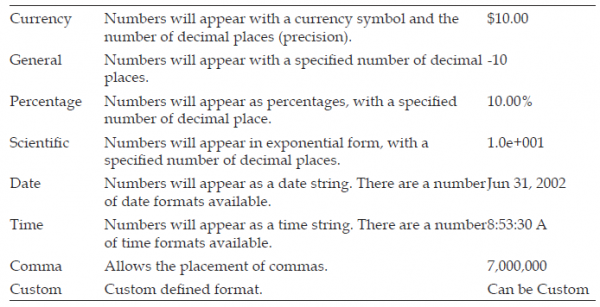To define an element’s type (numeric, consolidation or string), elements can have attributes defined and assigned to them. What is an attribute you ask? Well, if elements identify data in your cube, then you can think of the element attributes as describing the elements themselves, it’s that simple.
For example, let’s say that some of your users would like to display an account using the account name followed by the account number. Other users would like to display only the account name. You can define an alias attribute for each of these requirements. In fact, you can define as many alias attributes as you need.
Example:
I can have an account number of “01-0000-00001” and define multiple aliases so that the user can view the element as any of the following:
- “01-0000-00001”
- “01-0000-00001 – Long Surfboard”
- “Long Surfboard”
Some interesting uses for attributes include:
- To define features of elements. For example, an employee may have attributes that include “title”, “hire date”, or “department”
- To provide alternative or “friendly” names, or aliases. For example, an accounting code of “02-0000-00001” may have an alias of “salary and wages”
- To control the display format for the numeric data.
An alias attribute may also be used to present data in different languages!
You can also select elements by attribute value in the Subset Editor and display element names in TM1 windows using their aliases.
Creating an Attribute Is Easy!
To create attributes and assign attribute values, you use the TM1 Attributes Editor.
When adding attributes using the Attributes Editor, you will notice that it “defaults” to an attribute type of string, so be careful to select the desired type before proceeding. In most cases, I’ve used TurboIntegrator processes as the tool used to add, update, and delete my dimension attributes. You use the following programming functions:
• AttrInsert: To add a new attribute
• AttrPutN or AttrPutS: To update the attribute which can be numeric or string value
• AttributeDelete: To remove an existing attribute
A key point to know is that, if you try to view or update dimensions attributes and there are a large number of elements in the dimension when you open the Attributes Editor, you will receive a message as shown in the following screenshot:
You can potentially lock your TM1 session for a long time.
The alternative is to access the attributes of this dimension through the attributes cube instead, as it is much faster:
- Select View | Display Control Objects.
- Open the cube called }ElementAttributes_dimension.
- Modify the required fields like in any cube!
This is another important point. The }ElementAttributes cubes are known as Cognos TM1 control cubes. These cubes are automatically generated by TM1. As an clever developer you can either create a new (lookup) cube or use a control cube to look up data, depending upon your needs.
Some key attribute terminology and concepts you should be able to recognize are descriptive attributes, alias attributes, and when to use an attribute versus an additional element. Let’s briefly touch on these.
Descriptive attributes !
Descriptive attributes are simply the attributes which are data that describe the data. For example, consider some attributes for selecting a surfboard:
Alias attributes!
These attributes provide alternative names for elements:
It can be tempting to add many attributes to describe your elements and in most cases this is fine as you can filter your data by attribute value, however you should consider how your data is going to be used and presented. Sometimes it is more appropriate to create elements rather than attributes and sometimes even additional dimensions.
For example, board length is an attribute of surfboard models. The 6.6 boards often outsell the other length boards. If you create one element per board and another dimension with elements for each length, you can use TM1 to track surfboard sales by the length of the board. If you combine sales into a single board length, you might lose valuable detail.
Display format attributes!
A astute use for element attributes is formatting what is displayed in the Cube Viewer. When you create a dimension, an attribute named format is created for you automatically by TM1. This attribute can be used to set a display format for each individual numeric element.
Display format attributes can also be set programmatically with a TurboIntegrator process using the AttrPutS function. Just remember to add the c: to the format string to indicate that it is a custom format:
AttrPutS(‘c:###,###.00’, myDimensioName, myElementName, ‘Format’);
Referring to the IBM Cognos documentation, you see that the numeric data can be displayed in the following formats:
The Cube Viewer will display the format to use:
- Elements in the column dimension are checked for formatting.
- Elements are checked in the row dimension for display formats.
- Elements are checked in the title dimension for display formats (left to right).
The current view formatting is used.
Well, I hope this post is useful to you.
“If you’re doing something for the right reasons, nothing can stop you” – Duncan Me.







Is there a limit to the “amount” of attributes that can be created? I saw a tutorial on Cognos TM1 but could not understand the limitations of attributes. Could you reply and let me know and if so, is there a way to expand on those areas? Thanks
Actually, attributes as elements themselves, so in theory the limit to the number of attributes you could create on a single dimension on TM1 would be the maximum number of elements allowed in a TM1 dimension – pretty many. I have seem over 1,000 elements successfully created and used on a single dimension, but it was not a “user facing” dimension, more used by the TM1 model itself for processing requirements. To me, this is an extreme number and most likely not very realistic in practice.
Thanks for the query.